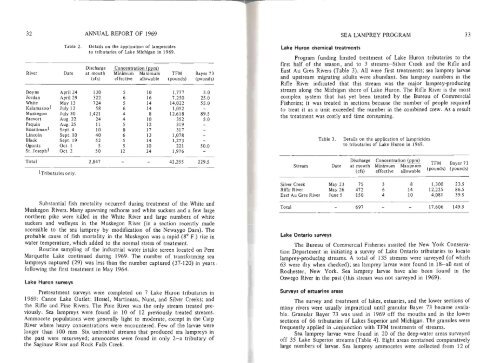Create successful ePaper yourself
Turn your PDF publications into a flip-book with our unique Google optimized e-Paper software.
32 ANNUAL REPORT OF <strong>1969</strong> SEA LAMPREY PROGRAM 33<br />
Table 2.<br />
Details on the application of lampricides<br />
to tributaries of Lake Michigan in <strong>1969</strong>.<br />
Discharge Concentration (ppm)<br />
River Date at mouth Minimum Maximum TFM Bayer 73<br />
(cfs) effective allowable (pounds) (pounds)<br />
Boyne April 24 130 5 10 1,777 5.0<br />
Jordan April 29 322 6 16 7,250 25.0<br />
White May 13 724 5 14 14,022 55.0<br />
Kalamazoo 1 July 12 58 6 14 1,052<br />
Muskegon July 30 1,421 4 8 12,618 89.5<br />
Brevort Aug. 22 24 4 10 352 5.0<br />
Paquin Aug. 25 11 5 12 319<br />
Boardman1 Sept. 4 10 8 17 317<br />
Lincoln Sept. 10 40 6 13 1,078<br />
Black Sept. 19 52 5 14 1,273<br />
Ogontz Oct. 1 5 5 10 221 50.0<br />
St. Joseph1 Oct. 2 50 12 24 1,976<br />
Total 2,847 - - 42,255 229.5<br />
1Tributaries only.<br />
Substantial fish mortality occurred during treatment of the White and<br />
Muskegon Rivers. Many spawning redhorse and white suckers and a few large<br />
northern pike were killed in the White River and large numbers of white<br />
suckers and walleyes in the Muskegon River (in a section recently made<br />
accessible to the sea lamprey by modification of the Newaygo Dam). The<br />
probable cause of fish mortality in the Muskegon was a rapid (8° F.) rise in<br />
water temperature, which added to the normal stress of treatment.<br />
Routine sampling of the industrial water intake screen located on Pere<br />
Marquette Lake continued during <strong>1969</strong>. The number of transforming sea<br />
lampreys captured (29) was less than the number captured (37-120) in years,<br />
following the first treatment in May 1964.<br />
Lake Huron surveys<br />
Pretreatment surveys were completed on 7 Lake Huron tributaries in<br />
<strong>1969</strong>: Canoe Lake Outlet; Hessel, Martineau, Nuns, and Silver Creeks; and<br />
the Rifle and Pine Rivers. The Pine River was the only stream treated previously.<br />
Sea lampreys were found in 10 of 12 previously treated streams.<br />
Ammocete populations were generally light to moderate, except in the Carp<br />
River where heavy concentrations were encountered. Few of the larvae were<br />
longer than 100 mm. Six untreated streams that produced sea lampreys in<br />
the past were resurveyed; ammocetes were found in only 2-a tributary of<br />
the Saginaw River and Rock Falls Creek.<br />
Lake Huron chemical treatments<br />
Program funding limited treatment of Lake Huron tributaries to the<br />
first half of the season, and to 3 streams-Silver Creek and the Rifle and<br />
East Au Gres Rivers (Table 3). All were first treatments; sea lamprey larvae<br />
and upstream migrating adults were abundant. Sea lamprey numbers in the<br />
Rifle River indicated that this stream was the major lamprey-producing<br />
stream along the Michigan shore of Lake Huron. The Rifle River is the most<br />
complex system that has yet been treated by the Bureau of Commercial<br />
Fisheries; it was treated in sections because the number of people required<br />
to treat it as a unit exceeded the number in the combined crew. As a result<br />
the treatment was costly and time consuming.<br />
Table 3.<br />
Details on the application of lampricides<br />
to tributaries of Lake Huron in <strong>1969</strong>.<br />
Discharge Concentration (ppm)<br />
Stream Date at mouth Minimum Maximum<br />
(cfs) effective allowable<br />
TFM Bayer 73<br />
(pounds) (pounds)<br />
Silver Creek May 23 75 3 8 1,300 23.5<br />
Rifle River May 26 472 6 14 12,225 86.5<br />
East Au Gres River June 5 150 4 10 4,081 39.5<br />
Total - 697 - - 17,606 149.5<br />
Lake Ontario surveys<br />
The Bureau of Commercial Fisheries assisted the New York Conservation<br />
Department in initiating a survey of Lake Ontario tributaries to locate<br />
lamprey-producing streams. A total of 135 streams were surveyed (of which<br />
63 were dry when checked); sea lamprey larvae were found in 18-all east of<br />
Rochester, New York. Sea lamprey larvae have also been found in the<br />
Oswego River in the past (this stream was not surveyed in <strong>1969</strong>).<br />
Surveys of estuarine areas<br />
The survey and treatment of lakes, estuaries, and the lower sections of<br />
many rivers were usually impractical until granular Bayer 73 became available.<br />
Granular Bayer 73 was used in <strong>1969</strong> off the mouths and in the lower<br />
sections of 66 tributaries of <strong>Lakes</strong> Superior and Michigan. The granules were<br />
frequently applied in I"Qnjunction with TFM treatments of streams.<br />
Sea lamprey larvae were found in 20 of the deep-water areas surveyed<br />
off 35 Lake Superior streams (Table 4). Eight areas contained comparatively<br />
large numbers of larvae. Sea lamprey ammocetes were collected from 12 of
















